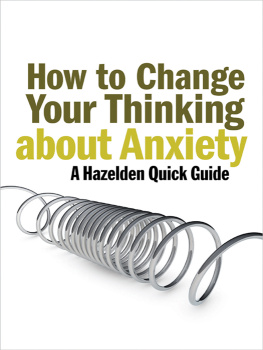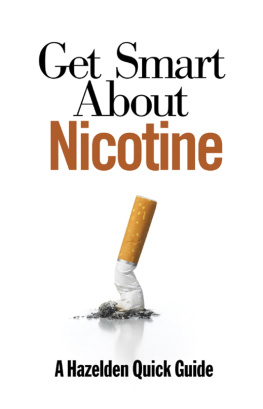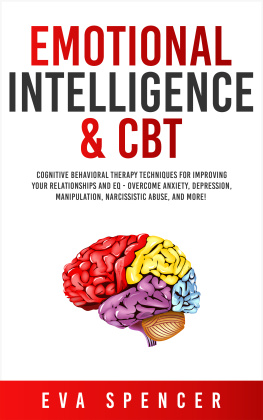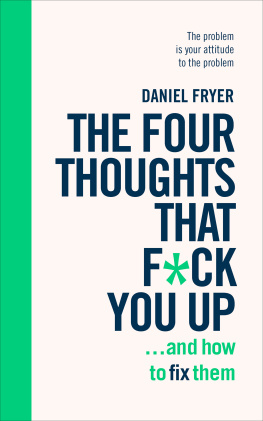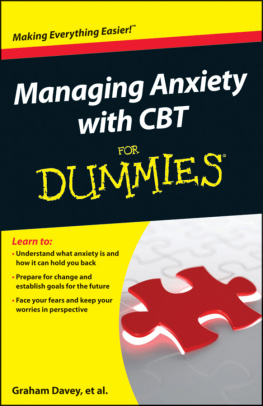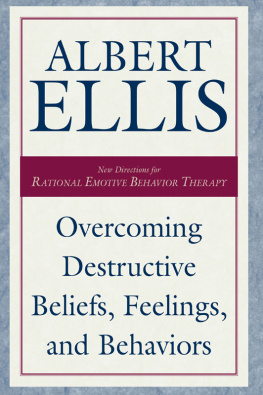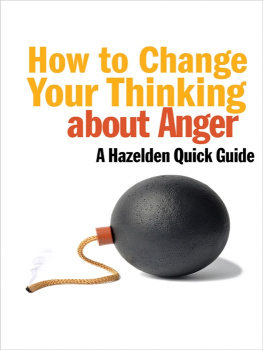How to Change Your Thinking about Anxiety
How to Change Your Thinking about Anxiety
A Hazelden Quick Guide

Hazelden
Center City, Minnesota 55012
hazelden.org
2012 by Hazelden Foundation
All rights reserved. Published 2012
Produced in the United States of America
No part of this electronic publication may be copied, sold, or redistributed in any form or by any means without written permission of the publisher. Failure to comply with these terms may expose you to legal action and damages for copyright infringement.
E-book ISBN: 978-1-61649-435-3
Editors note
The names, details, and circumstances may have been changed to protect the privacy of those mentioned in this publication.
This publication is not intended as a substitute for the advice of health care professionals.
Alcoholics Anonymous and AA are registered trademarks of Alcoholics Anonymous World Services, Inc.
Cover design by Theresa Jaeger Gedig
About Hazelden Quick Guides
Hazelden Quick Guides are short, accessible e-books that draw on the original work and best practices of leading experts to help readers address common addiction recovery and emotional health issues.
This first four-book collection applies the proven methods of Rational Emotive Behavior Therapy (REBT) to challenge and change the irrational thoughts and beliefs that contribute to the debilitating effects of shame, anger, depression, and anxiety.
I am an old man and have known many troubles, most of which never happened.
Mark Twain
Getting the Most from This Book
Anxiety is a gripping, gnawing fear that occurs in the absence of any real threat. This feeling can lead to a level of distress that disrupts everything in your life.
Perhaps youve downloaded this e-book because you have a problem with anxiety. You might be struggling with this problem in secret, alone, using strategies that once worked but now seem to consistently fail.
You came to the right place. Welcome.
As youll soon see, you are not alone in struggling with anxiety. Scientific researchalong with the real-world experience of people who cope successfully with anxietyhas yielded a rich store of solutions. Let this book be your point of access to them.
Remember that you dont have to believe anything you read here. Theres nothing you have to take on faith. You wont find any eternal verities or timeless truths. What you will find are tools for change. Use them. Test them. See if they make a difference for you.
The principles and practices in this book come from recognized experts on anxiety, including authors published by Hazelden. This information has been distilled for you here in a single source that you can read in one sitting.
People who join self-help groups based on the Twelve Steps of Alcoholics Anonymous have a saying: The program works if you work it. You may find that this describes your experience of this book. To get the most value from it, be willing to do three things: First, consider the ideas presented in each chapter and be willing to change your thinking. Next, experiment with the suggested changes in behavior. Finally, evaluate the results of those changes. Discover which of them make a positive difference for you.
This process of putting ideas into action works best when you take it in baby steps. Translate the suggestions from this book into simple changes in thinking and behavior that you can make right away. Make one change at a time, evaluate the results, and then come back to this book for more practical ideas.
Heres whats coming up in the following chapters:
- Discover the anatomy of anxiety. Anxiety feels like an overpowering, mysterious force. But in reality, its made up of discrete elementsthoughts, physical sensations, and behaviors. Stepping back to take these elements apart and examine them one by one is a first step to managing anxiety.
- Learn about the different forms of anxiety. While anxiety is a universal human experience, we experience it in unique ways. An accurate diagnosis lays a foundation for effective treatment and self-care.
- Uncover the sources of anxiety. Your biology and your life experiences are key factors in creating anxiety. In addition, many people find that their strategies for coping with anxiety actually increase their level of distress over the long run. Their solution has become part of the problem.
- Discover how you experience anxiety. Ironically, accepting the facts about your current thoughts, feelings, and behaviors opens up the possibility of changing them.
- Know how and when to get help. The earlier you intervene to stop the spiral of anxiety disorders, the sooner you can feel relief. Theres no need to go it alone. Psychotherapy and medication can set the stage for positive change.
- Reclaim your life from anxiety, one day at a time. This book draws on the teachings of Rational Emotive Behavior Therapy (REBT), which has a successful track record for people with anxiety. You can use self-help techniques drawn from REBT and other sources to unravel the patterns of thinking, feeling, and behaving that are linked to anxiety.
As you experiment with the tools for change suggested in this book, youll see the effects in your daily life. The process could transform your experience of anxietyand your life.
The Anatomy of Anxiety
Anxiety is the dizziness of freedom, wrote Sren Kierkegaard, the Danish philosopher. That statement makes you wonder whether he ever actually felt anxiety.
How can you be free when your muscles are locked in tension and you start to shake? When youre short of breath or feel like youre slowly being smothered? Theres dizziness, yes, but also hands that go hot and sweaty or cold and clammy, a heart that pounds furiously in your chest, and thoughts that race at blinding speed.
Along with this assault on your senses comes a fear that youre falling into an abyss, that all your efforts to stay in control are doomed, that youre going crazy, that you might even die. You scan the environment for a place to escapesomewhere, anywhereand feel an urge to run and hide.
In the midst of all this agitation, there is a path to serenity. It begins with understanding something about the nature of emotions in general. Once you step back from the experience of any emotion, take it apart, and put it under a microscope, youll start to free yourself from it.
Three Points about Feelings
Begin with the fact that human beings are feeling beings. In any given moment on any given day, were feeling somethingpleasant, unpleasant, or neutral. We may not always express our feelings to other people. And sometimes were not even fully aware of them. But feelings are happening anyway, flowing like a deep river of movement and change inside us and determining our direct experience of daily life.
We also have a push-pull relationship with feelings: We cling to the pleasant ones and we resist the unpleasant ones. While this works reasonably well most of the time, our tendency to cling and resist sometimes gets us into trouble. We adopt an adversary relationship with our feelings. We struggle to change them, control them, and fix them. At times we put so much effort into getting our emotions right that we twist ourselves into emotional knots.
At any momenteven when youre feeling extremely afraid, sad, or madyou can get back in balance. You can start to untwist yourself by remembering three key points about the nature of emotions.

